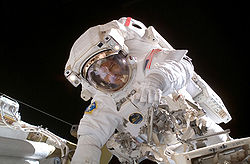ISS Expedition 14 patch
The NASA insignia for design for shuttle flights and station increments is reserved for use by the astronauts and for other official use as the NASA Administrator may authorize. Public availability has been approved only in the form of illustrations by the various news media. When and if there is any change in this policy which is not anticipated, it will be publicly announced.
Relevantní obrázky
Relevantní články
Michael López-AlegríaMichael Eladio López-Alegría, původně letec Námořnictva USA je od března 1992 americkým astronautem, členem oddílu astronautů NASA, 333. člověk ve vesmíru. Zúčastnil se celkem pěti misí, poprvé v roce 1995 na palubě raketoplánu Columbia, krátkodobé lety raketoplánem Space Shuttle si zopakoval v roce 2000 a 2002 během výstavby Mezinárodní vesmírné stanice (ISS). Počtvrté do vesmíru a potřetí na ISS se dostal jako člen Expedice 14, tentokrát v ruském Sojuzu a na dlouhodobé misi dlouhé 215 dní. Také v roce 2022 pobýval 16 dní na Mezinárodní vesmírné stanici (ISS) během kosmického letu Axiom Mission 1 a na stejné místo se vrátil také počátkem roku 2024 při letu Axiom Mission 3. Během svých šesti letů strávil ve vesmíru necelých 297 dní. .. pokračovat ve čtení






